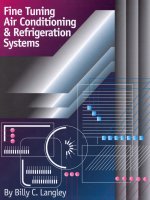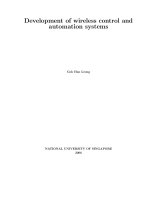Fact Sheet: intracity heavy rail and metro systems
Bạn đang xem bản rút gọn của tài liệu. Xem và tải ngay bản đầy đủ của tài liệu tại đây (208.87 KB, 2 trang )
Low Carbon Green Growth Roadmap for Asia and the Pacific
FACT SHEET
Intracity heavy rail and metro systems
Bangkok
Photo: Ko Sakamoto
Heavy rail and metro system explained
Metropolitan railways are urban, electric transport systems with high capacity and a high frequency of service.
Metros are totally independent from other traffic, road or pedestrians. They are consequently designed in tunnel,
viaducts or on surface level but with physical separation. In Asia, metro systems are being developed or
expanded in many developing cities including Bangkok, New Delhi and Singapore.
Performance, evaluated
Capacity
Geographical range
Implementing cost
High: Approximately 1,000 persons per vehicle, with peak capacity
at 45,000 people per hour per direction and typical capacity
between 20,000 and 30,000.1
Medium to high (from up to 20 km to beyond 20 km)
High: dependency upon a number of factors, such as management
and organizational structure and the land and labour costs. Costs
run about US$55 million to $207 million per kilometre.
Payback period
High (more than 10 years)
Applicable city size
Applicable stage of
development
Large (more than 5 million inhabitants)
Developing and developed, Appropriate generally in cities with more
than 5 million inhabitants or linear spatial development and with at
least US$18,000 per capita annual income.2
• Metropolitan rapid transit in Bangkok, Thailand
• Star metro in Kuala Lumpur, Malaysia
Examples
Strengths of bus rapid transit
•
•
High carrying capacity.
High frequency and reliability of service – more than 700,000 trips per day.
1
German Agency for International Cooperation (GIZ) website “International Fuel Prices”. Available from
www.gtz.de/en/themen/29957.htm (accessed 22 February 2012).
2
Lloyd Wright and K. Fjellstrom, Sourcebook Module 3a: Mass Transit Options (Eschborn, Germany, GIZ, 2004).
Low Carbon Green Growth Roadmap for Asia and the Pacific : Fact Sheet - Intracity heavy rail and metro systems
•
•
Lowest energy use and CO2 emission per person per kilometre of the mass transport options.
Major transit interchanges along the route can catalyse high-density development, if managed
effectively.
Challenges to using bus rapid transit
•
•
•
•
•
Lengthy construction times.
A high level of investment is needed for the required infrastructure.
High level of skill required for maintenance and operation.
Requires exclusive right-of-way status.3
Construction on steep gradients is technically and financially difficult.
Limitations
Due to the high capital and operational costs, rail-based systems are most appropriate in cities with a large
population, where passenger capacities are expected to exceed 25,000 passengers per direction per hour.
Implementing strategies
Secure financial resources for the initial costs: Land value taxes or long-term loans from bilateral and multilateral
development banks (such as Asian Development Bank) help to secure capital.
Designate an institutional body with professional expertise: The body should be responsible for setting fares and
for ensuring that the timetable is integrated with other transport services in urban areas.4
Plan to meet financial sustainability of the operation: Financial viability of the operation can be secured through
increased ridership. The measures include densification of land use around stations, effective integration with
existing transport modes and policies that can stimulate feeder services and good interchange facilities
between modes; the development of complementary mass transit systems.5
Further reading
Sourcebook Module 3a: Mass Transit Options, by L. Wright and K. Fjellstrom (Eschborn, GTZ (GIZ), 2004).
3
German Agency for International Cooperation (GIZ) website “International Fuel Prices”. Available from
www.gtz.de/en/themen/29957.htm (accessed 22 February 2012).
4
5
Lloyd Wright and K. Fjellstrom, Sourcebook Module 3a: Mass Transit Options (Eschborn, Germany, GIZ, 2004).
German Agency for International Cooperation (GIZ) website “International Fuel Prices”. Available from
www.gtz.de/en/themen/29957.htm (accessed 22 February 2012).









